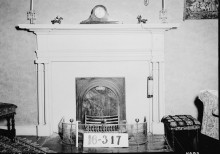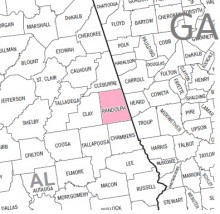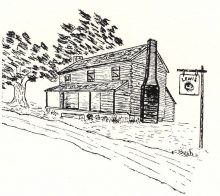THEY WANT TO BE ONE
SCROLL DOWN TO CONTINUE STORY
Girard and Phenix City will be united into a big town
(Transcribed from The Montgomery Advertiser June 21, 1890)
The Municipality of Girard Discontinued – Both Towns Willing – Mass meetings last night The Legislature will be appealed to for aid, as each town is in a different county
Columbus, GA. June 20 [Special]
There is a movement on foot in Phenix City and Girard to have the two places united in one municipality. This movement grew out of a recent decision of the Supreme Court of Alabama declaring certain sections of the act creating the Peabody School District (Girard) to be unconstitutional.
This decision practically dissolved the town without power or authority to give its citizens police protection. The movement to unite the two towns will be combatted from the jump, and a number of citizens of Girard have filed application with the Judge of Probate of Russell county for incorporation under the general laws of the State.
Girard Public School, Girard, Ala. ca. 1910 (Alabama Department of Archives and History)
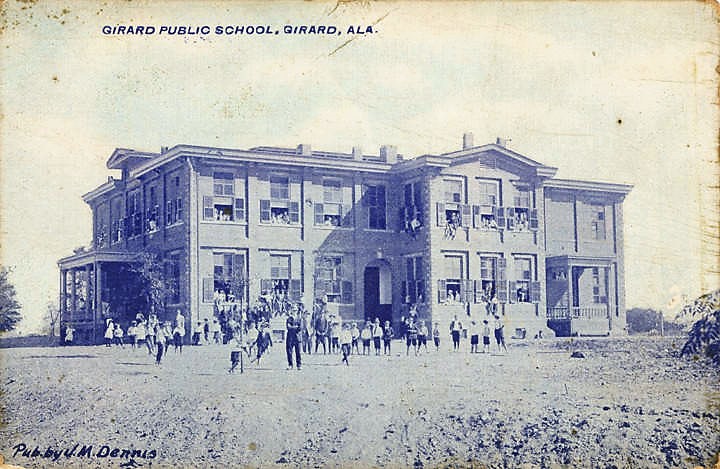
The friends of the movement to unite the two places are enthusiastic and are confident that they will be able to carry out their plans. Phenix City and Girard have a population of not less than six thousand souls, and if the two towns are made one it will be the largest city in East Alabama. The chief difficulty is the way is that Girard is in Russell County and Phenix City in Lee. An act of the Legislature, however, can remove this difficulty.
A mass meeting of the citizens of the two places will be held in Phenix City tonight, and it is likely that the meeting will give the movement practical shape.
The mass meeting held in Phenix City last night to take steps, looking to the consolidation of the towns of Phenix City and Girard was largely attended and quite lively in some respects.
On motion, a committee of six, composed of T. S. Young, W. B. Teft, H. Williams, E. G. Bennett. C. W. Fields and J. S. Roberts, was appointed to draft resolutions looking to a union of the two towns. While the committee was out a general expression of opinion was indulged in, which showed that a desire for consolidation largely prevailed. The Committee reported a set of resolutions embodying the general outlines for consolidation. A lively discussion arose on a motion to adopt the resolutions as a whole. It was finally agreed to adjourn the meeting to next Thursday night, when the resolutions offered by the Committee will be discussed and acted upon by sections.
A great deal of interest is being manifested in the movement in both Phenix City and Girard, and next Thursday night’s meeting will be a hummer.
The premature explosion of a dynamite cartridge on a small island in the Chattahoochee this morning seriously injured two negro laborers, William Anderson and Jim Powell. The latter lives in Girard. He will recover, but Anderson may die.
Additional information from transcriber
The city of Girard merged into Phenix City on August 9, 1923, giving the newly enlarged town a combined population of 10,374.
The following history of Girard is from History of Alabama and Dictionary of Alabama Biography published 1921, by Thomas McAdory Owen.
Girard, Alabama was a city in the far north-east corner of Russell County, Alabama across the Chattahoochee River from Columbus, Georgia. In 1900, the population was 3,840 and in 1910 it grew to 4,214. It had a bank, two newspapers, a cotton mill and a brick manufacturing company.
Land given by Creek chief
Girard and Phenix City are both included in the original “Ben Marshall Reserve,” a section of land opposite the city of Columbus, Georgia, with the Chattahoochee River as the eastern boundary. It was given to a Creek chief, Ben Marshall, by the terms of the treaty of March 24, 1832, between the United States and the Creek Nation. On June 19, 1832, this tract was purchased by Col. Daniel McDougald and Dr. Robert Collins of Georgia, for $35,000
The first house in the town was built by Horace King, a slave, for John Godwin, his master, in October, 1832. On the establishment of the county in the same year, a commission composed of Hardemen Owens, Anderson Abercrombie and Thomas M. Martin, was appointed to select a site for the courthouse. Girard was chosen, but it was generally conceded that it would not be permanent, and substantial buildings were not constructed.
Charles Abercrombie home near Girard, Alabama, March 1917 (Alabama Department of Archives and History)
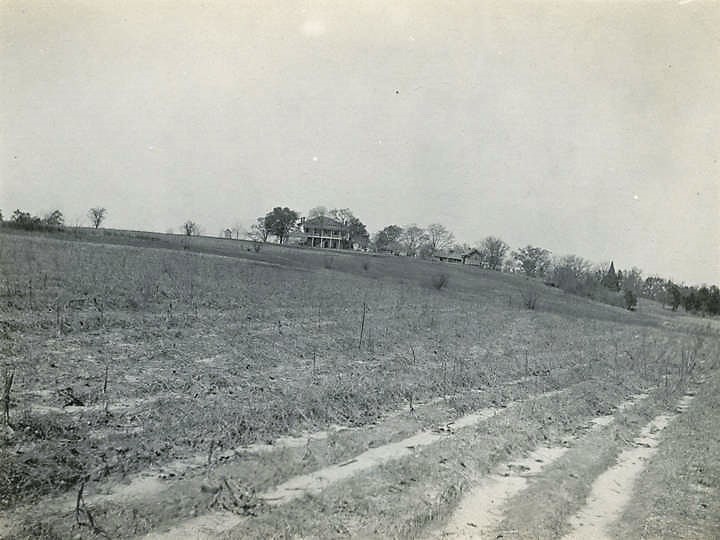
Dillingham Street covered bridge over the Chattahoochee River between Columbus, Georgia and Girard, Alabama ca. 1900 (Alabama Department of Archives and History)
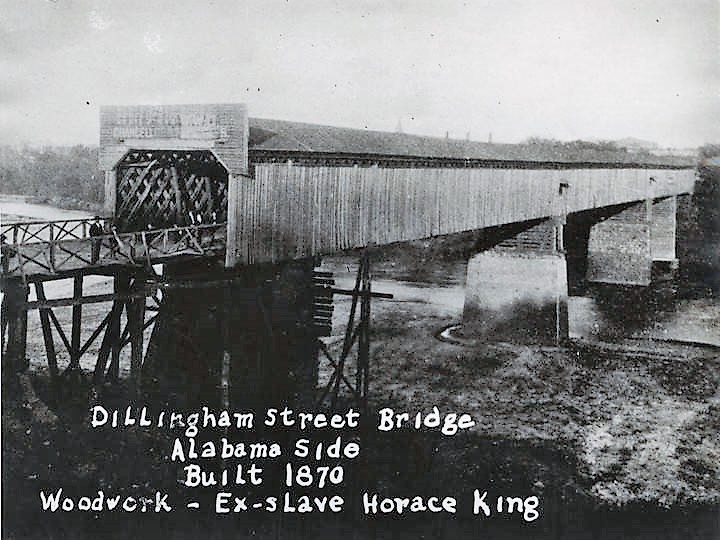
The courthouse was built on the hill west of the lower bridge connecting the city with Columbus, Ga. Neither it nor the jail had been completed in 1839 when the seat of justice was changed to Crockettsville (Crawford). The first court convened at Girard on October 14, 1833, and was held in John Godwin’s workshop, on the hill near the Methodist Church. The town being just across the State line opposite Columbus, Ga., was for many years the refuge of a lawless element; and for that reason was for a long time known as Sodom, but never officially given that name. The post office was established in 1840, with Wm. B. Harris as postmaster.
On April 16, 1865, the last engagement of the War (Civil War) took place there, during which the Confederates burned the bridges leading to the Georgia side. The Abercrombie family, long prominent in the State’s history, settled river plantations immediately below the place, about the time of the removal of the Indians.
Benjamin H. Baker practiced law there from 1840 to 1850, at which time he removed to Crawford. The Holland family was among its first settlers, as were Martin G. Buchanan and Wm. Faulkenberry. Mr. Buchanan was an overseer for Paddy Carr, an Indian chief, who had plantations on the river below. John Godwin was a contractor and builder. His foreman was Horace King who built most of the houses both in Columbus and Girard during the first 15 years of their existence.
Paddy Carr (Alabama Department of Archives and History)
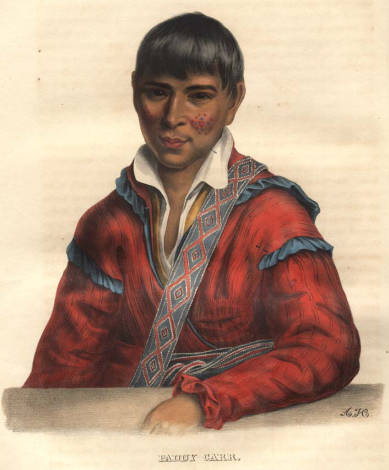
All of the bridges spanning the river before the War were built by King. He was the grandson of a Catawha Indian of South Carolina, and was emancipated by the legislature in February 1848. After the death of Mr. Godwin, some years later, the family then being in destitute circumstances, King assumed the wardship of the widow and children, taking care of the former as long as she lived. Benjamin Marshall, an Indian chief of means, was one of the first settlers in the town. The famous trial of Jere Austill, then United States marshal, and his associates, for the killing of Hardeman Owens, took place there in October 1833.
TAPESTRY OF LOVE SERIES: Three Books in One
Inspired by actual people and historical events of colonial America, “The Kingdom of Accawmacke” is revealed and secrets about America’s history are discovered in this well-researched series. The story begins in 17th century England during the reign of Charles I and continues a family’s journey to the eastern shore of Virginia and Maryland.


